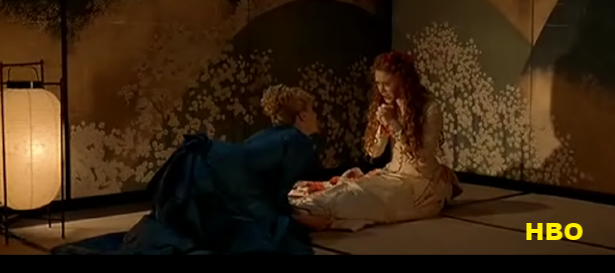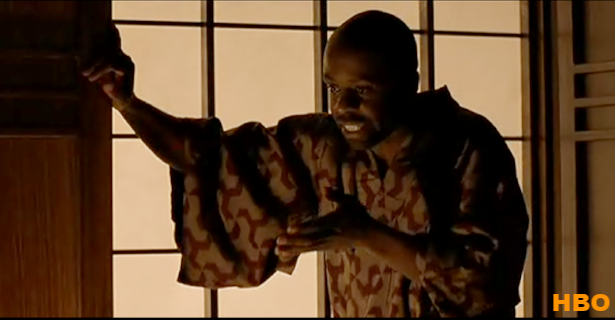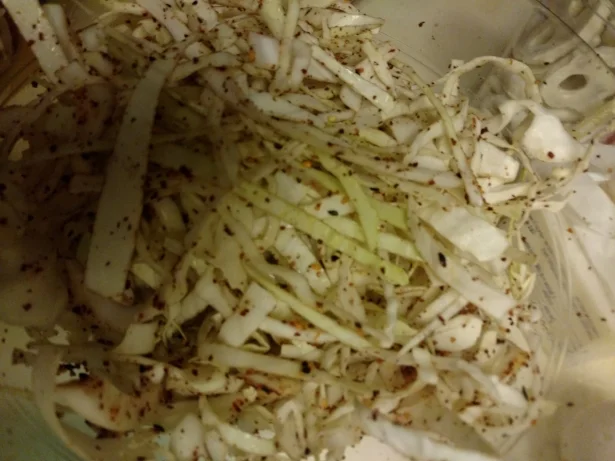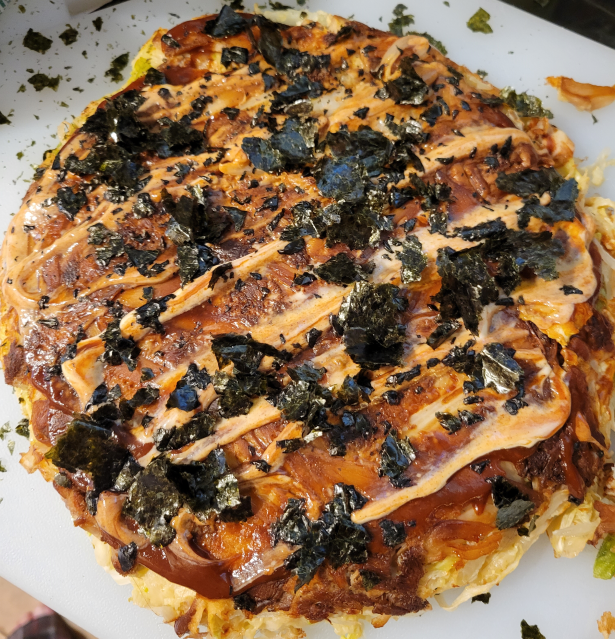KC 95 - Okonomiyaki (Japanese "Pancakes")

Okonomiyaki. What a wonderful phrase. Okonomiyaki, ain’t no passing craze!
Why hello there, and welcome to Kitchen Catastrophes. As ever, I’m your host with the most ability to infect your mind with Disney-derived earworms, Jon O’Guin. Today, we’re going to talk about a Japanese repast of no small renown, and also, Shakespeare. Why? Because I’m the only person who decides what we talk about, so I get to make whatever mad decision I want. Buckle up, things are gonna get weird.
Cabbage Cribbage Babbage Pillage
Ignore Title Jon, he’s just going a little crazy. Today’s recipe is covering Okonomiyaki. What is that, and how the hell do you say it? Glad you asked, Rhetorical Device Man!
Okonomiyaki, pronounced “Oh-koh-no-me-yah-ki”, comes from two Japanese words: yaki meaning “grilled” (That’s why so many Japanese foods include the sound: Teriyaki, Yakisoba, Yakitori, etc.) and okonomi meaning “What/how you want”. I’m not certain, as I am NOT a Japanese speaker, nor are my linguistic credentials in Asian cultures particularly strong (I’m better at Romance and Germanic constructions), but I really hope that it’s the positive form of “whatever.” Like, when your spouse asks what you want to eat, and you say “I don’t know, whatever you want.” Because the idea that there’s a WORD for that in Japanese would just be swell.
A wonderfully polite people. (Note; if you've never read Manga before, the dialogue balloons are right-to-left. I'm sorry if there was any confusion, I should have warned you before the image.)
Historically, the evolution of the okonomiyaki, is well, pretty simple: Since roughly the 1670’s, give or take a decade, small crepe-like pancakes have been served in Japan, first as a Buddhist dessert. Over the centuries, they evolved, Sometimes the focus was on the sauce, sometimes the crepes got filled with onions, etc. Around the 1920’s or 30’s the modern version, the actual “okonomiyaki”, was born. (All the previous dishes were named something else. Hell, technically several versions of modern okonomiyaki are called something else.) There’s disagreement on who exactly made what first: Osaka made the style I’m making today, while Tokyo made a much runnier version they called “monjayaki”, and Hiroshima made a layered version, but the results were basically the same: a fried dough cake stuffed with veggies and meat with various toppings, sauces, and fillings.
Seriously, one source I encountered cited no less than SIX “Key” Ingredients, along with 37 different suggested options. If that sounds weird or excessive, it might be easier understood if remembered the common American dish of BAKED dough cake, covered with various sauces, toppings, meats, and veggies.
Ground beef, bacon, cheddar, ketchup, mustard, pickle... That's already 6 toppings.
Yes, a common nickname for the dish is ‘the Japanese Pizza’. Just like you can probably rattle through your opinions on a bunch of toppings for a pizza, so an Osaka eater could bore their date by talking about their preferred Okonomiyaki toppings for too long.
I’ll explain the recipe I used (It’s simple as spit…a phrase I immediately regret using in a cooking post) and how I’d modify it, but first, I want to talk about Shakespeare, so sit down, this shit’s gonna get mildly Academic and uncomfortably personal, just like the plot of Oleanna!
A Lion Stuffed in a Stable looks Ridiculous, because that is Not Where Lions Belong
Listen, there’s something I’ve been…aching to do. And going without it has felt, at some points, like living missing a limb. Like a raw itch I can’t scratch, that just tears at the walls of my internal stability, clawing up from my heart like acid reflux burning my throat. So I’m going to indulge myself here.
I have not had a chance to be a fucking Theatre nerd in too damn long.
It's been months since I've been justified in wearing my wigs!
That may sound trivial to you, but it’s VERY important to me. In case you’ve forgotten, or didn’t know to begin with: Theatre is what I was collegiately trained in. Of the jobs I’ve had as a functioning adult, it was directly responsible for over half of them. I’ve been paid to give lectures on theatre, paid to perform it, paid to run technical aspects of it. I’ve worked eighteen-hour-long days of theatre, and gotten up the next day and done more. I’ve done, by my count, over six thousand hours of theatre. It is a crucial part of my identity.
Now, due to scheduling problems and important life-events, I haven’t had a chance to ACT in almost a year and a half. I haven’t done improvisational comedy, another precious part of me, in even longer. (Or maybe just barely shorter, I’d have to check.) And the one I really miss, the one that we’re about to jump into, I haven’t had a chance to Dramaturge in over two years.
Now, for those who aren’t theatrically inclined, or only work on the community level, you may have never heard that term, so what is a Dramaturge? Simply put, they’re the encyclopedia of a professional show. They’re the one who double checks design choices and helps directors and actors with the minutiae of a script. Things like, in Shakespeare, helping an actor understand jokes that are four-hundred-year old references
Luckily, I have an in. You may recall that okonomi is the Japanese word for “How you like”, or, phrased another way “AS YOU LIKE IT”, the Shakespeare play that, for no apparent reason, Kenneth Branagh decided to set in Japan during the Meiji Restoration, AND THAT’S A GOOD ENOUGH FUCKING REASON FOR ME TO TALK ABOUT IT, AND ALL THE WEIRD SHIT THAT GOES ON IN IT.
That's David Oyelowo, future star in such movies as Interstellar, Selma, Lincoln, and Rise of the Planet of the Apes, preparing to perform sumo in, I must remind you, AN ADAPTATION OF SHAKESPEARE. A black guy, doing sumo, in Shakespeare. What a brave new world.
“As You Like It” is supposedly one of Shakespeare’s more popular works to be produced, a claim made about basically every one of his plays that aren’t the fucking Histories, though scholars dispute exactly how, well, GOOD it is. George Bernard Shaw thought it was pretty crap, but he wanted to be Shakespeare so fucking bad I suspect the only reason his wife’s name wasn’t Anne Hathaway is because he couldn’t convince her to change it. (Side Note: George Bernard Shaw liked to joke that he and his wife never consummated their marriage. That’s a weird boast, right? “Pssh, all you assholes out here fucking your wives! MY WIFE is too pure for that shit!” It almost loops back around and becomes impressive.)
In any case, it’s the story of a lot of drama that gets resolved REALLY EASILY in the last like, 3 pages. Plot summation: A dude overthrows his brother, the duke, and the duke flees the dude into the woods. The Dude keeps the Duke’s daughter (and yes, I AM continuing to use “dude” and “Duke” solely to mess with you) in the castle because the Dude’s daughter, her cousin, needs a friend. Meanwhile, some dead guy’s two sons are fighting, because the old son is screwing over the young son. To prove himself, the young son wrestles Charles, showing off for the Dude. Sadly, while getting complimented, the young son finds out his dead guy dad was a Duke’s Dude, not a Dude’s Dude, so he’s got to skedaddle but not before he flirts with the Duke’s Daughter, who later leaves town with her cousin, Dude’s Daughter.
Dude's Daughter (left) and Duke's Daughter (right), discussing skedaddling from Dude's Palace, once Duke's Palace. If you think my comments make it confusing, it's worth noting this movie uses THE SAME ACTOR for the Duke and his brother.
The middle of the play is honestly mostly “Yada yada”: a lot of shepards and people in disguises falling in love with people who aren’t who they say they are. The Duke’s Daughter, while dressed as a boy, has several scenes “pretending” to be herself so she can teach Young Son how to woo her. The play ends with them all getting married to their “right” match, and the wedding gets interrupted for a messenger (who, SURPRISE, is the missing brother of the two sons of Dead Guy) to tell everyone: “Hey, the Dude was coming here to kill you all, but he met a magic hermit and has instead decided to be a forest hermit forever. We can all go home now!” The End.
Like I said last week with Garfield, at least we can see it’s not renowned for its PLOT. In my honest opinion, As You Like It is a pretty good show, however, because it’s not ABOUT the plot. Instead, what it’s about is FUN. See, as I’ve mentioned before, back in Shakespeare’s day, people cared a lot more about how they said what they said than we do now, because it was basically the only way of having fun. Literacy was something like 31%, the internet didn’t exist, and you can only dance, drink, and sing so much in a day, so conversations were a little more poetic. And that is rampant in this show. Every character who exists for more than one scene has at least one section where they’re philosophizing, or quipping, or getting great emotional moments.
This is the second-tier villain, the old son, weeping that his brother is so much better than him. That sounds ridiculous, but I assure you, he makes it work.
HBO Go actually has the version I've been talking about, if you want to watch it. Some disagree with his choices (He reduced Rosalind, AKA, THE FEMALE LEAD’s lines, by a notable bit.) and some say that Kevin Kline’s Jacques is inferior to Alan Rickman’s of a decade before, but all in all, I felt it was well-acted and well-paced, only dragging for a couple minutes about a third of the way through.
Ahhhhhhhhhhhhhhh. You have no idea how good that felt. And I didn't even GET into things like specific jokes, cultural isolation, little tricks the film used to double up on character roles, or any of that. Just SUMMARIZING a play like I used to felt like a great stretch. Alright, Let’s wrap this bad boy up.
Fry Me to The Moon
So, the recipe I have came from Cooking Light, and I will immediately warn you: it’s not for everyone. I served this to my family, and my father took one bite, spat it out, and declared he needed something else for dinner. That’s not as damning as it sounds, nor as soul-crushingly disappointing as it felt in the moment: As I’ve noted several times, my father’s tolerance for flavors and textures has been hugely compromised by his illness. Even foods he KNOWS he likes have been inedible as he’s undergone treatment. My brother, on the other hand, thought it was basically delightful, with him endorsing it to my aunt and uncle as they visited. But, still, it’s an off-beat recipe.
The core of the recipe is simple: make a batter, stir in the fillings, and fry into cakes. This specific variety relied on Shichimi Togarashi for much of the flavoring.
Seen here posing for a Calvin Klein cologne ad.
Shichimi Togarashi, also known as Japanese Seven-Spice, is…well, it’s a mix of Seven Spices, duh. Specifically, it’s typically something like red pepper flakes, ground pepper, 2 sesame seeds, seaweed, citrus peel, and garlic/ginger. It’s a little sweet, mostly spicy, and it goes on basically everything fatty or rich.
This recipe uses it to flavor the cabbage, by tossing finely shredded strands in a mixture of shicimi, salt, and sugar, and letting them brine shortly. I used up about a quarter of a head of cabbage making the pancakes for my whole family.
You'd think eventually I'd learn how to avoid casting a shadow over the food I'm photographing, but sometimes I just forget.
Toss those brined bad-boys with some crumbled pre-cooked bacon, green onions, egg and flour, and…yeah, at this point, you’re basically done. Or rather, this is where you can choose to get weird: cabbage, bacon, and green onion are pretty common ingredients, so now add…what you like. Corn, Small shrimp, basically any small sliced or diced seafood… But we went with the basic recipe we had.
The batter gets slapped down into a tablespoon of pre-heated oil, and cooked 3-4 minutes, before you flip it. Personally, I tried to do the cool “pan toss flip” on all of my pancakes, and failed on all but the last one. Everyone else I had to flip with a spatula.
This is what success looks like.
Once they’re cooked, you serve them. Traditionally, you top them with (well, again, basically anything) but Mayonnaise and a savory sauce, along with more green onions, and maybe some sesame seeds are pretty basic. Like “the cheese pizza” of okonomiyaki toppings. We actually made a sauce by mixing the shichimi, some mayo, oil, and vinegar. It was…Fine.
Personally, my impression of the result, an impression my brother calls correct, was of “a crab cake, minus the crab”. There was something to the slightly eggy batter and the hot cooking temp that put me in mind of a crustacean-based snack. Next time, I definitely want more bacon, and maybe some ham, pickled ginger, I don’t know. I just know I’ll make it As I Like It.
THURSDAY: JON CONTINUES HIS STAY IN JAPAN WITH SOME BASIC JAPANESE PANTRY STAPLES, IN A NEW SEGMENT HE CALLS “ABROAD’S PANTRIES”, A PUN HE MADE UP LITERALLY ON THE SPOT, AND IS NOW SAD HE WILL HAVE TO CONTINUE USING.
MONDAY: SWEET, SWEET, MEAT. IN PASTE FORM!
Recipe
Okonomiyaki
Serves 4 people
Ingredients
5 cups finely shredded cabbage. (Huh. Honestly, I only sliced it. I’ve only just now noticed that’s not what it said to do.)
4 tsps shichimi togarashi, divided into 1 tbsp + 1 tsp
1 ½ tsp sugar
½ tsp salt
½ cup green onions, thinly sliced, divided into 2 equal batches
5 large eggs, lightly beaten
4 slices of bacon, pre-cooked and crumbled (I would increase this to at least 6.)
2/3 c all purpose flour
2 tbsp vegetable oil
¼ c mayonnaise
1 tbsp rice vinegar
1 tbsp water
Additional toppings/ingredients to your taste.
Preparation.
1. Preheat oven to 200 degrees F. Combine the cabbage, 1 tbsp shichimi, salt, and sugar in a bowl, and let stand 15 minutes, stirring occasionally.
2. Add eggs, bacon, and ½ of the green onions to bowl, stirring to mix. (You may add additional ingredients at this time as well) Then, fold in flour.
3. Take 1.5 tsp oil and heat in 8 inch skillet over medium high heat. Add 1 c f batter to the pan, flatten with a spatula, and cook 3-4 minutes, until golden brown, then flip and cook another 2-3 minutes. Place fried pancake on baking sheet and store in oven to keep warm as you repeat the process 3 more times.
4. Mix the mayonnaise, remaining shichimi, vinegar, and water into a sauce. Serve okonomiyaki topped with mayo-sauce, green onions, and, you know, whatever.















